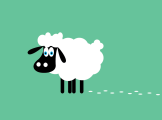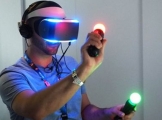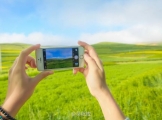|
我一直在努力将 CIDetector(面部检测)结果转换为相对于显示图像的 UIImageView 的坐标,以便我可以使用 CGPaths 绘制坐标。
我查看了这里的所有问题以及我能找到的所有教程,其中大多数使用在 UIImageView (example) 中显示时未缩放的小图像。 我遇到的问题是使用在 UIImageView 中显示时使用 aspectFit 缩放的大图像并确定正确的比例 + 平移值。
在使用不同尺寸/长宽比的图像进行测试时,我得到的结果不一致,所以我认为我的程序存在缺陷。我已经为此苦苦挣扎了一段时间,所以如果有人有一些提示或可以对我做错的地方进行 X 光检查,那将是一个很大的帮助。
我在做什么:
- 获取人脸坐标
- 使用下面的
frameForImage 例程(在 SO 上找到)来获取 UIImageView 图像的比例和边界
- 为缩放 + 平移创建变换
- 对 CIDetector 结果应用转换
//我确定变换值的例程
NSDictionary* data = [self frameForImage:self.imageView.image inImageViewAspectFit:self.imageView];
CGRect scaledImageBounds = CGRectFromString([data objectForKey "bounds"]);
float scale = [[data objectForKey "bounds"]);
float scale = [[data objectForKey "scale"] floatValue];
CGAffineTransform transform = CGAffineTransformMakeScale(scale, -scale);
transform = CGAffineTransformTranslate(transform,
scaledImageBounds.origin.x / scale,
-(scaledImageBounds.origin.y / scale + scaledImageBounds.size.height / scale)); "scale"] floatValue];
CGAffineTransform transform = CGAffineTransformMakeScale(scale, -scale);
transform = CGAffineTransformTranslate(transform,
scaledImageBounds.origin.x / scale,
-(scaledImageBounds.origin.y / scale + scaledImageBounds.size.height / scale));
CIDetector 结果转换使用:
mouthPosition = CGPointApplyAffineTransform(mouthPosition, transform);
//错误结果示例:比例尺似乎不正确

//在 SO 上找到的下面的例程,用于确定使用 'aspectFit` 在 UIImageView 中缩放的图像的界限
-(NSDictionary*)frameForImage UIImage*)image inImageViewAspectFit UIImage*)image inImageViewAspectFit UIImageView*)myImageView
{
float imageRatio = image.size.width / image.size.height;
float viewRatio = myImageView.frame.size.width / myImageView.frame.size.height;
float scale;
CGRect boundingRect;
if(imageRatio < viewRatio)
{
scale = myImageView.frame.size.height / image.size.height;
float width = scale * image.size.width;
float topLeftX = (myImageView.frame.size.width - width) * 0.5;
boundingRect = CGRectMake(topLeftX, 0, width, myImageView.frame.size.height);
}
else
{
scale = myImageView.frame.size.width / image.size.width;
float height = scale * image.size.height;
float topLeftY = (myImageView.frame.size.height - height) * 0.5;
boundingRect = CGRectMake(0, topLeftY, myImageView.frame.size.width, height);
}
NSDictionary * data = [NSDictionary dictionaryWithObjectsAndKeys:
[NSNumber numberWithFloat:scale], @"scale",
NSStringFromCGRect(boundingRect), @"bounds",
nil];
return data;
} UIImageView*)myImageView
{
float imageRatio = image.size.width / image.size.height;
float viewRatio = myImageView.frame.size.width / myImageView.frame.size.height;
float scale;
CGRect boundingRect;
if(imageRatio < viewRatio)
{
scale = myImageView.frame.size.height / image.size.height;
float width = scale * image.size.width;
float topLeftX = (myImageView.frame.size.width - width) * 0.5;
boundingRect = CGRectMake(topLeftX, 0, width, myImageView.frame.size.height);
}
else
{
scale = myImageView.frame.size.width / image.size.width;
float height = scale * image.size.height;
float topLeftY = (myImageView.frame.size.height - height) * 0.5;
boundingRect = CGRectMake(0, topLeftY, myImageView.frame.size.width, height);
}
NSDictionary * data = [NSDictionary dictionaryWithObjectsAndKeys:
[NSNumber numberWithFloat:scale], @"scale",
NSStringFromCGRect(boundingRect), @"bounds",
nil];
return data;
}
Best Answer-推荐答案
我完全理解你想要做什么,但是让我为你提供一种不同的方式来实现你想要的。
- 您的图片尺寸过大
- 你知道 imageView 的大小
- 询问图片的 CGImage
- 确定一个“比例”因子,即 imageView 宽度除以图像宽度
- 将此值与您的图像高度相乘,然后从 imageViewHeight 中减去结果,以获得 imageView 中的“空”高度,我们称之为 'fillHeight'
- 将 'fillHeight' 除以 2 并四舍五入得到下面使用的 'offset' 值
使用 UIGraphicsBeginImageContextWithOptions(imageView.size, NO, 0) 提供的上下文,绘制你想要的任何颜色的背景,然后绘制你的 CGImage
CGContextDrawImage(context, CGRectMake(0, offset, imageView.size.width, rintf(image.size.height*scale)), [图像CGImage]); 使用以下方法获取此新图像:
UIImage *image = UIGraphicsGetImageFromCurrentImageContext();
UIGraphicsEndImageContext();
返回图片; 设置图片:imageView.image = image;
现在您可以准确地映射回您的图像,因为您知道确切的缩放比例和偏移量。
关于ios - 将 CIDetector(人脸检测)结果转换为 UIImageView 坐标,我们在Stack Overflow上找到一个类似的问题:
https://stackoverflow.com/questions/12201603/
|  客服电话
客服电话
 APP下载
APP下载

 官方微信
官方微信
















 "bounds"]);
float scale = [[data objectForKey
"bounds"]);
float scale = [[data objectForKey
 UIImage*)image inImageViewAspectFit
UIImage*)image inImageViewAspectFit
